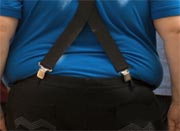
THURSDAY, March 7 (HealthDay News) — The first five patients to try a new, minimally invasive weight-loss procedure dropped an average of more than 45 pounds in six months, researchers report.
The procedure — called gastric artery chemical embolization (GACE) — works by blocking an artery in the stomach. This cuts off part of the blood supply to an area of the stomach that produces most of the hormone ghrelin, which stimulates appetite.
“If a large, randomized study shows similar results, this may be a very simple method and an alternative to bariatric surgery,” said lead researcher Dr. Nicholas Kipshidze, with New York Cardiovascular Research in New York City.
However, an expert noted that when one hormone is targeted, the body usually finds other ways to compensate. And another expert said the procedure must be studied in far more people for much longer periods to make sure there aren’t major complications and that weight loss persists.
The findings were scheduled to be presented Sunday at the annual meeting of the American College of Cardiology, which begins this weekend in San Francisco. The data and conclusions of research presented at meetings should be viewed as preliminary until published in a peer-reviewed journal.
In this first human test, researchers treated five obese people. Patients had a catheter placed in their groin. The catheter was threaded through an artery until it reached the upper part of the stomach, called the gastric fundus. Then, tiny beads were run through the catheter to block the artery.
Although blood flow to the stomach is reduced, the risk of part of the stomach dying from lack of blood is small, because these tissues get blood from other blood vessels, explained Kipshidze, who is also the general director at Republican Hospital in Tbilisi, Georgia.
After a month, patients lost about 29 pounds; by three months they had lost an average of 37 pounds and at six months the average weight loss was 45 pounds, the researchers said.
In addition, ghrelin levels also dropped. After a month, levels had fallen 29 percent, and at three months it had fallen by 36 percent. At six months, however, ghrelin levels were only 18 percent below where they had been before the procedure.
This pattern is one to be expected, according to Dr. David Katz, director of the Yale University Prevention Research Center.
“Ghrelin is one of many hormones known to influence hunger and appetite, and in every prior attempt to change long-term weight outcomes by manipulating one hormone, we found compensatory mechanisms that kick in over time and the benefits tend to wear off,” he said.
“So [the new procedure] is unlikely to prove to be an alternative to the lifestyle approaches, namely eating well and being physically active,” Katz said.
Study author Kipshidze noted that the new study did not address lifestyle factors. To really test the effectiveness of the procedure, he didn’t tell the patients to change their diets or exercise.
“I told them ‘Do what you want. Go and eat as much as you want,'” he said. “Their appetite decreased and they simply couldn’t eat. Their intake was dramatically decreased.”
According to Kipshidze, the procedures went off without a hitch, and so far there have been no complications. The long-term outcomes in terms of sustained weight loss and side effects, however, are still unknown, he said.
Gastric artery chemical embolization has several advantages over current weight-loss procedures, such as gastric bypass surgery and gastric banding, Kipshidze said.
These other procedures are major operations with all the consequences of any operation, including hospital stays and long recovery times, he said. But with this new technique, “You do the procedure in the morning, and you can send the patient home the same day.”
He noted that this procedure is a type of gastric artery embolization that has been used for years to treat bleeding in the intestines and reduce side effects from chemotherapy for advanced liver cancer.
Whether there will be complications down the line or whether patients will gain the weight back, as many do after other weight-loss surgery, isn’t clear, Kipshidze said.
“Who knows with this procedure whether patients will gain the weight back? I cannot tell you; I don’t know what is going to happen,” he said.
That answer is the key to whether this procedure will be a viable alternative to other types of weight-loss surgery, another expert said.
“The question is, will this thing work in a lot of people over a long period of time, and what’s the complication rate and what’s the mortality with it,” said Dr. Stephen Green, associate chairman of the department of cardiology at North Shore University Hospital in Manhasset, N.Y.
“If this works, it would be fantastic — it would be a game changer,” he said. “But this is not ready for prime time.”
Kipshidze is planning larger clinical trials where some patients — including some with diabetes — will undergo the procedure while others will have a sham procedure. In all, they will need to include about 30 patients to be sure the procedure is safe and effective, he said. The procedure is also being refined with new equipment and techniques.
More information
For more about obesity, visit the U.S. National Library of Medicine.

